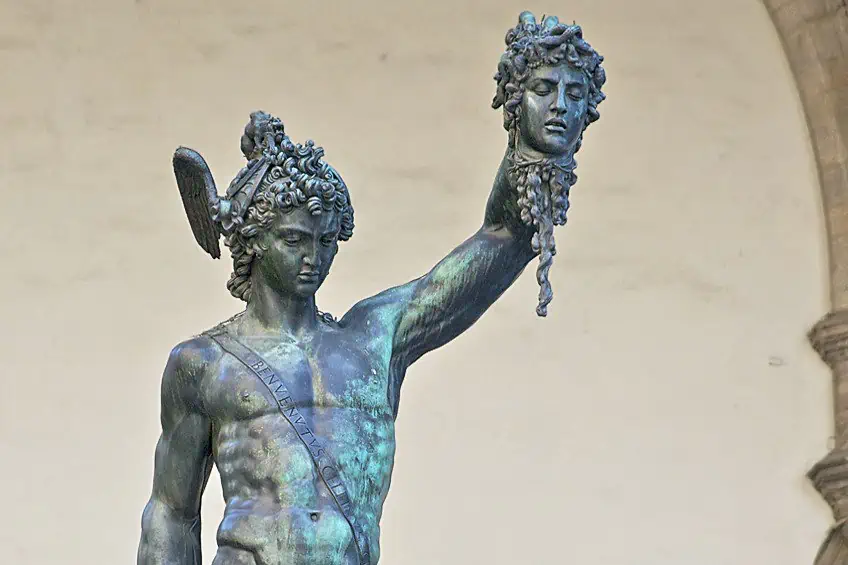Famous Bronze Sculptures – Explore 15 Metal Marvels
Explore the raw emotion behind our selection of the top 15 most famous bronze sculptures in art history. From masterpieces by Donatello to Auguste Rodin, these timeless bronze statues and sculptures have been cherished as iconic works that unravel the medium and talents of these famous sculptors. Keep reading to learn more about the 15 most iconic bronze sculptures of all time, including a brief history of bronze in art!
Contents
- 1 An Introduction to Bronze in Art: Material, Symbolism, and Use
- 2 Exploring the 15 Most Famous Bronze Sculptures in Art History
- 2.1 Discobolus (c. 460 – 450 BCE) by Myron
- 2.2 Boxer at Rest (c. 330 – 50 BCE) by Unknown
- 2.3 Equestrian Statue of Marcus Aurelius (c. 181 CE) by Unknown
- 2.4 David (c. 1430 – 1440) by Donatello
- 2.5 Perseus with the Head of Medusa (c. 1545 – 1554) by Benvenuto Cellini
- 2.6 Manneken Pis (1619) by Jérôme Duquesnoy the Elder
- 2.7 Bronze Horseman (1782) by Étienne Maurice Falconet
- 2.8 The Gates of Hell (1880 – 1917) by Auguste Rodin
- 2.9 The Bronco Buster (1895) by Frederic Remington
- 2.10 The Thinker (1904) by Auguste Rodin
- 2.11 Sleeping Muse (1909 – 1910) by Constantin Brâncuși
- 2.12 The Little Mermaid (1913) by Edvard Eriksen
- 2.13 The Vine (1921) by Harriet Whitney Frishmuth
- 2.14 L’Homme au Doigt (1947) by Alberto Giacometti
- 2.15 Maman (1999 – 2002) by Louise Bourgeois
- 3 Frequently Asked Questions
An Introduction to Bronze in Art: Material, Symbolism, and Use
For centuries, bronze has held a significant place in history and sculpture as an expression of human creativity and innovation. Its symbolism has evolved to transform concepts and characters into physical statues and structures that influence the way we understand and appreciate certain aspects of early civilizations and cultures. As an alloy of tin and copper, bronze has been used by many early civilizations. It is a material that is appreciated for its durable quality and its historic significance as an indicator of status.
The use of bronze as an artistic medium dates back to the ancient peoples of Mesopotamia and the Indus Valley around 3300 BCE.
The refinement of bronze sparked significant technological development since it introduced a malleable material that enabled artists to produce detailed sculptures, tools, and weapons. For many ancient cultures, bronze objects were often modeled after important deities, rulers, and warriors to symbolize power, strength, and divinity, among ruling parties.

In ancient Egypt, bronze statues were created as homes for the spirits, which were rooted in beliefs of eternal life. For ancient Greeks and Romans, bronze sculptures and statues of Gods and emperors symbolized political power and divine influence, which seeped into religious art throughout the Medieval period. For centuries, bronze itself was associated with social status and had become a symbol of wealth. Owning bronze objects signified nobility and affluence and were usually commissioned by rulers and aristocrats to emphasize their social standing and “refined” artistic tastes.
During the Italian Renaissance, sculptors like Lorenzo Ghiberti and Donatello resurrected classical bronze casting techniques, which reintroduced a new method of expression.
Exploring the 15 Most Famous Bronze Sculptures in Art History
Art periods such as the Baroque period saw the use of bronze in sculpture to convey strong emotions and dramatic movements, which influenced the way modern artists approached the medium. Below, we have compiled a list of the 15 most famous bronze statues and sculptures in art that will renew your appreciation of the medium.
Discobolus (c. 460 – 450 BCE) by Myron
| Artist Name | Myron of Eleutherae (c. 480 – 440 BCE) |
| Date | c. 460 – 450 BCE |
| Medium | Bronze |
| Dimensions (cm) | 160 (h) |
| Where It Is Housed | National Museum of Rome, Rome, Italy |
The Discobolus by Myron of Eleutherae is recognized as one of the most famous bronze statues of antiquity, which was created in the 5th century BCE. Widely recognized as a masterpiece of ancient Greece, this dynamic bronze statue portrays an athletic man captured in a moment of peak tension as he is caught frozen in an impending throw.
Discobolus is a great example of action statuary, which was most common in the Classical period. The stance of the athlete was sculpted to emphasize the anticipation of his action and the concentration that went into throwing the discus.
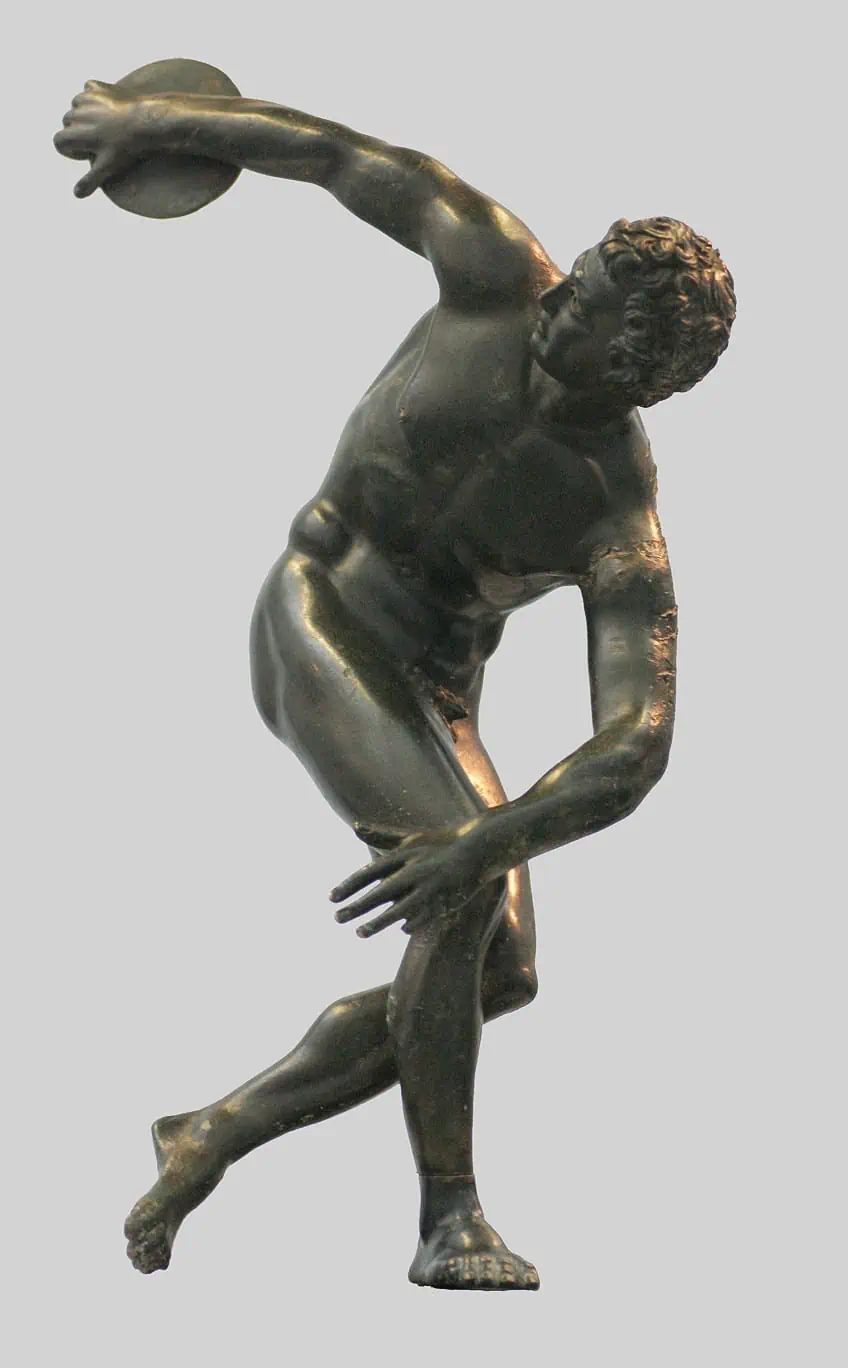
The intricate detail of musculature also captures Myron’s energy in an expression of intense physicality that has been copied onto marble with as much likeness as possible. The original bronze statues were lost to time, however, the famous Discobolus statue remains immortal via the many Roman copies that capture the essence of Myron’s talents.
Boxer at Rest (c. 330 – 50 BCE) by Unknown
| Artist Name | Unknown |
| Date | c. 330 – 50 BCE |
| Medium | Bronze |
| Dimensions (cm) | 128 (h) |
| Where It Is Housed | Palazzo Massimo alle Terme, Rome, Italy |
Sculpted by an unknown artist, this iconic bronze statue was also dubbed the Terme Boxer and was created between 330 and 50 BCE. The sculpture is significant in terms of its visual qualities considering the period it was produced in. The sculptor chose to depart from the notion of idealized heroic figures to capture the image of a boxer with stark realism.
The figure was posed in a resting position, which is a complete turnaround from the norms of Greek sculpture, which relied on representing figures with heroism and youthfulness.
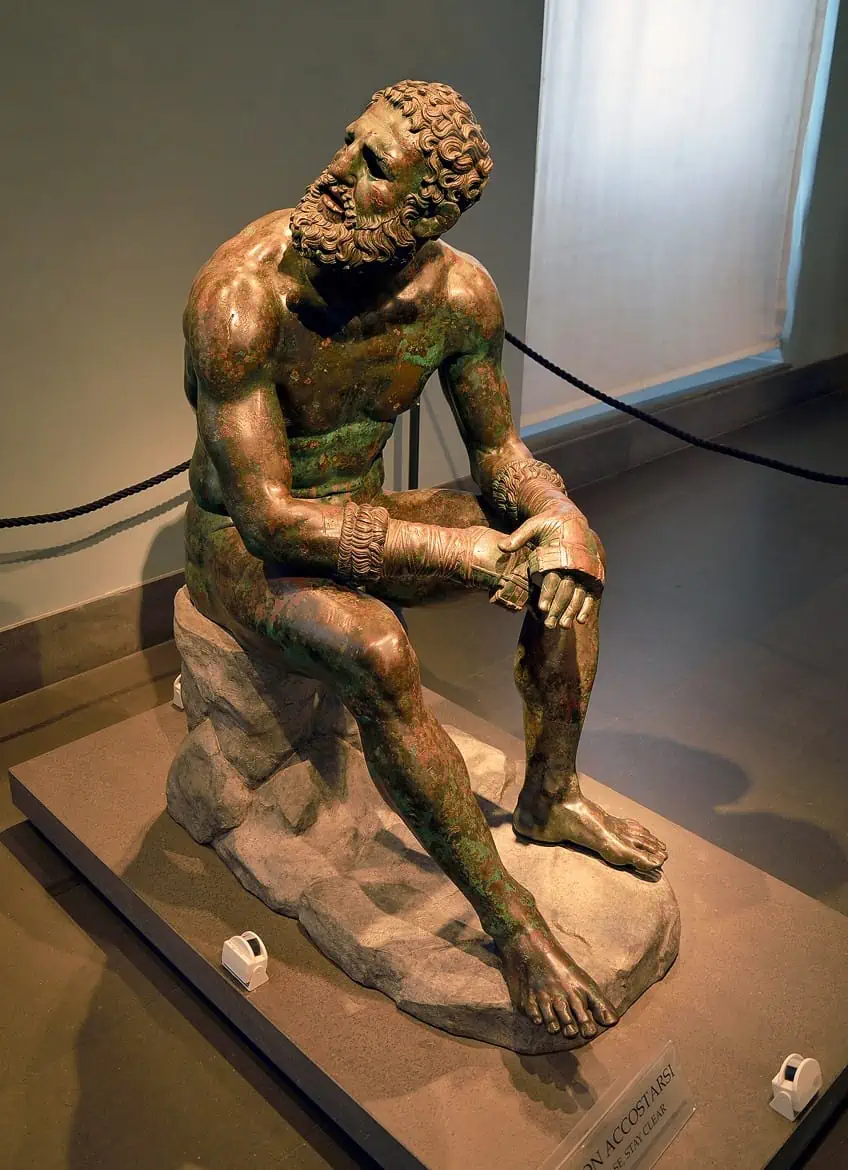
The statue was discovered in 1885 and is currently housed in the Palazzo Massimo alle Terme at the National Museum of Rome. Furthermore, the Hellenistic style of the statue and emotional depth make the artwork particularly appealing to those who prefer to explore the depths of the psychology behind such idealized figures and the portrayal of ancient boxers. The statue was unearthed alongside another bronze sculpture, which was believed to hail from the Baths of Constantine.
Equestrian Statue of Marcus Aurelius (c. 181 CE) by Unknown
| Artist Name | Unknown |
| Date | c. 181 CE |
| Medium | Bronze |
| Dimensions (cm) | 424 (h) |
| Where It Is Housed | Capitoline Hill, Rome, Italy |
The Equestrian Statue of Marcus Aurelius stands as a Roman symbol of leadership and power, which was originally sculpted in the 2nd century CE to capture the likeness of the Roman emperor Marcus Aurelius on horseback. The sculpture shows Aurelius gesturing with an adlocutio stance that was popular among emperors when addressing their soldiers.
The sculpture differs from other conventional bronze martial sculptures of its time in that this equestrian statue depicted Aurelius without any armor or weapons.
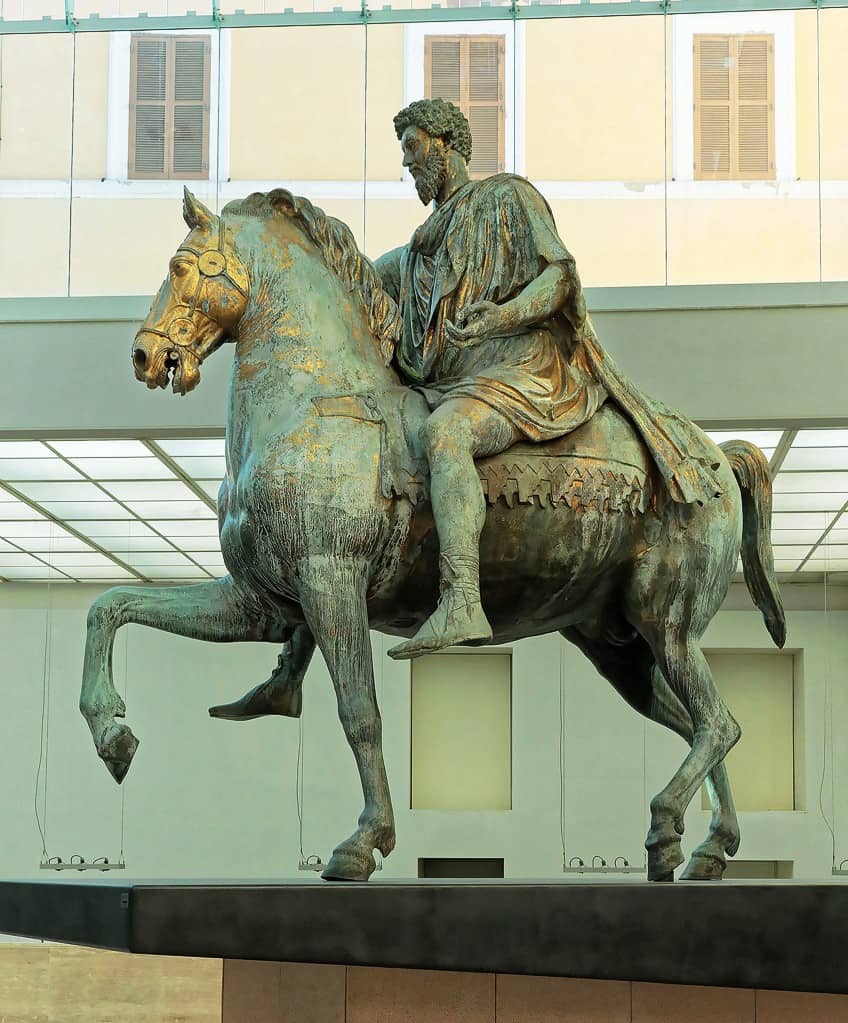
The sculpture thus evokes themes of wisdom and peace as one is met with an alternative representation of the emperor. A copy of the bronze stands at the Piazza del Campidoglio while the original statue is housed at the Palazzo dei Conservatori of the Musei Capitolini.
David (c. 1430 – 1440) by Donatello
| Artist Name | Donato di Niccolò di Betto Bardi (1386 – 466) |
| Date | c. 1430 – 1440 |
| Medium | Bronze |
| Dimensions (cm) | 158 (h) |
| Where It Is Housed | Bargello National Museum, Florence, Italy |
David by Donatello is perhaps one of the most famous bronze statues that was created between 1430 and 1440. The statue is housed at the Museo Nazionale del Bargello in Florence and represents the heroic biblical figure of David in the complete nude.
The famous statue was initially sculpted in marble between 1408 and 1409 and later created in bronze.
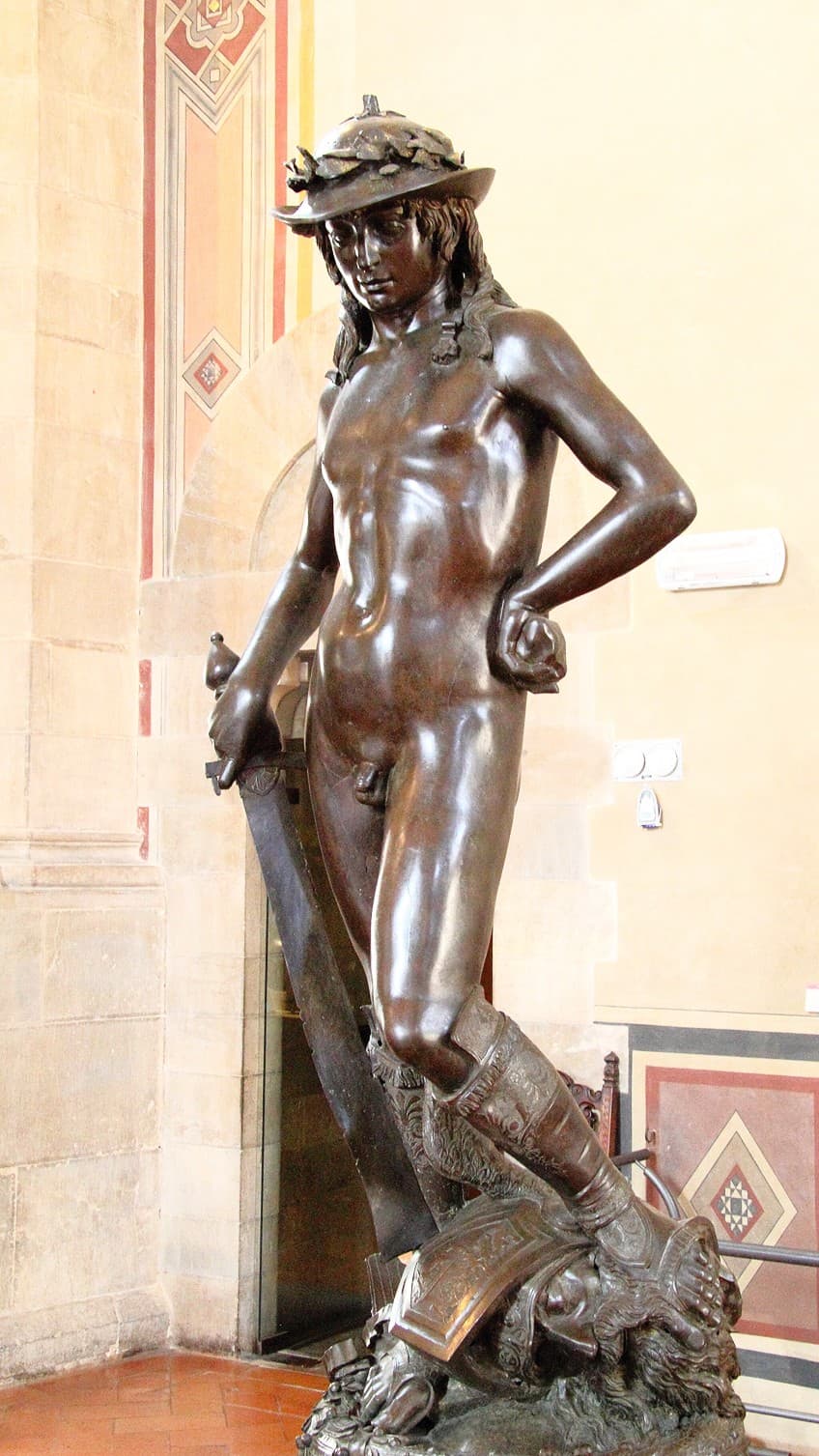
The first sculpture was a commissioned piece for religious use and was created in a significantly modest size than the bronze David. The bronze version was commissioned by the influential Medici family as a symbol of defiance and was the first male statue that was created since antiquity.
Perseus with the Head of Medusa (c. 1545 – 1554) by Benvenuto Cellini
| Artist Name | Benvenuto Cellini (1500 – 1571) |
| Date | c. 1545 – 1554 |
| Medium | Bronze |
| Dimensions (cm) | 305 x 132 x 137 |
| Where It Is Housed | Piazza della Signoria, Florence, Italy |
Created between 1545 and 1554 by Benvenuto Cellini, Perseus with the Head of Medusa is a famous bronze statue that stands at the Piazza della Signoria. Widely considered a bronze masterpiece, the statue depicts the demigod Perseus in a heroic pose while showing pride in his defeat of the mythological character Medusa.
The sculpture is a symbol of victory and an ode to Perseus’ brute strength as he holds the severed head of Medusa.
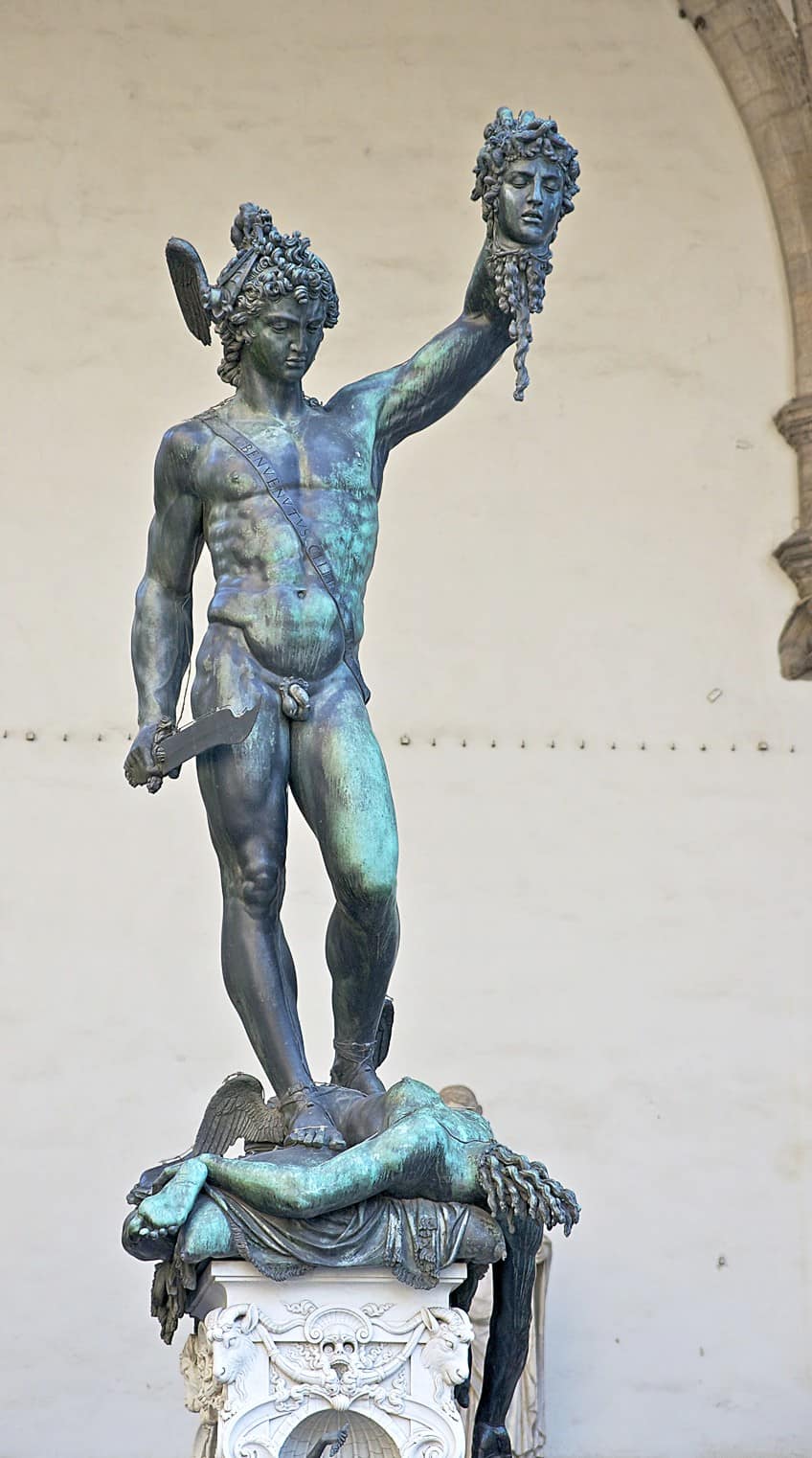
The statue rests on a base that is decorated with detailed bronze relief panels that contain narrative scenes from the tales of Perseus and Andromeda. Despite the one-sided narrative of Perseus’ triumph over Medusa, Cellini’s work is still admired for his meticulous detail to the serpentine locks of hair on Medusa’s head and the detail on Perseus’ muscles.
Manneken Pis (1619) by Jérôme Duquesnoy the Elder
| Artist Name | Jérôme Duquesnoy the Elder (1570 – 1641) |
| Date | 1619 |
| Medium | Bronze |
| Dimensions (cm) | 55.5 (h) |
| Where It Is Housed | Corner of Rue de l’Étuve/Stoofstraat and Rue des Grands Carmes/Lievevrouwbroerstraat, Brussels, Belgium |
Manneken Pis is another popular bronze statue that is located in the heart of Brussels. The bronze statue is a 55.5-centimeter-tall statue that depicts a defiant and whimsical little boy who appears to urinate in a fountain. The statue was created by a Brabantine artist called Jérôme Duquesnoy the Elder around 1619 and has also endured many acts of vandalism, and even theft. The stone niche of the sculpture was decorated in the rocaille style, which was popular in the 1770s.
The statue is also said to embody the living tradition of Brussels with all its humor and resilience encapsulated by the mischievous figure.
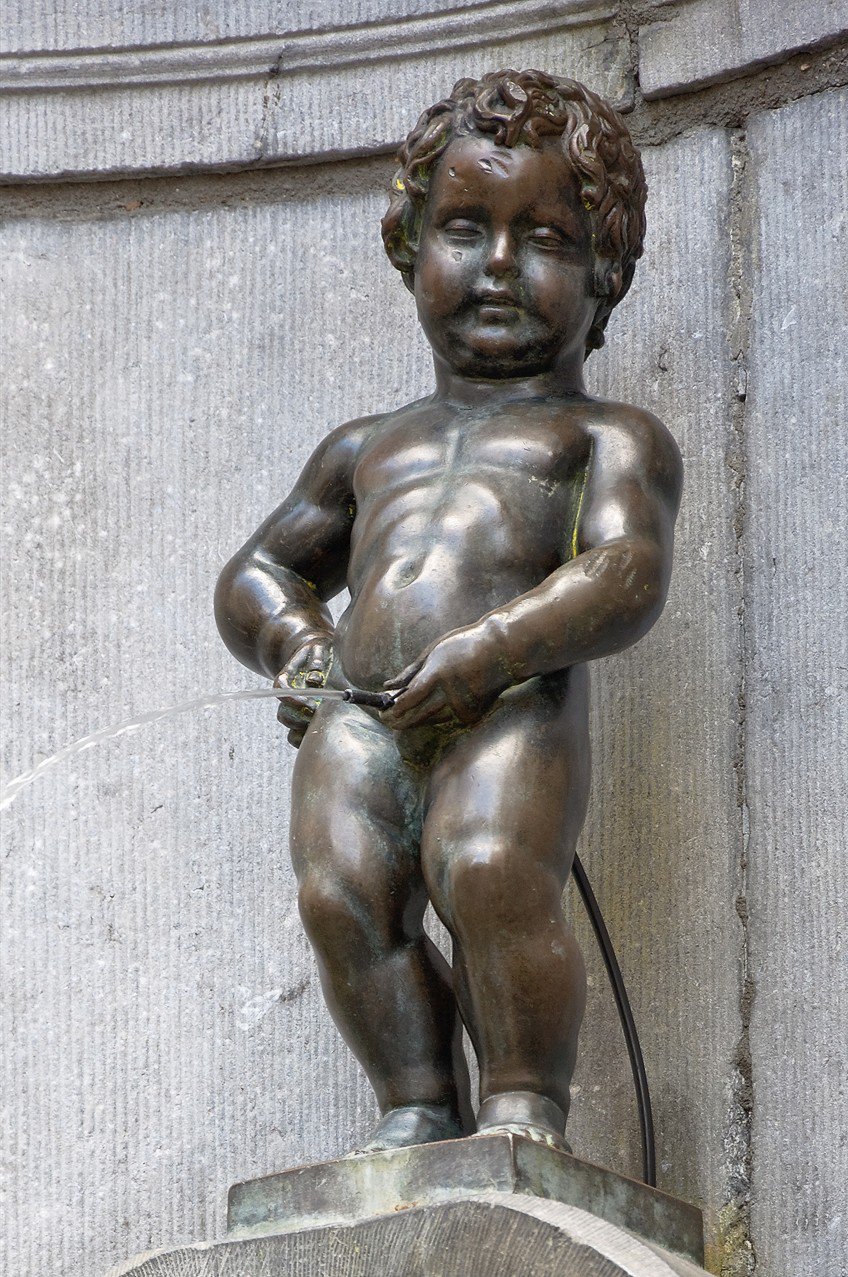
Bronze Horseman (1782) by Étienne Maurice Falconet
| Artist Name | Étienne Maurice Falconet (1716 – 1791) |
| Date | 1782 |
| Medium | Bronze |
| Dimensions (cm) | 1300 (h) |
| Where It Is Housed | Senate Square, Saint Petersburg, Russia |
Bronze Horseman is among the most famous bronze sculptures of the 18th century that was created by the Neoclassical sculptor Étienne Maurice Falconet on a commissioned project for Catherine the Great. The sculpture currently stands at the Senate Square in Saint Petersburg and is a symbol of forbidden love during the Leningrad blockade.
The majestic bronze sculpture was unveiled in 1782 and depicts the Russian leader Peter the Great mounted on horseback and resting on the iconic Thunder Stone granite monolith.
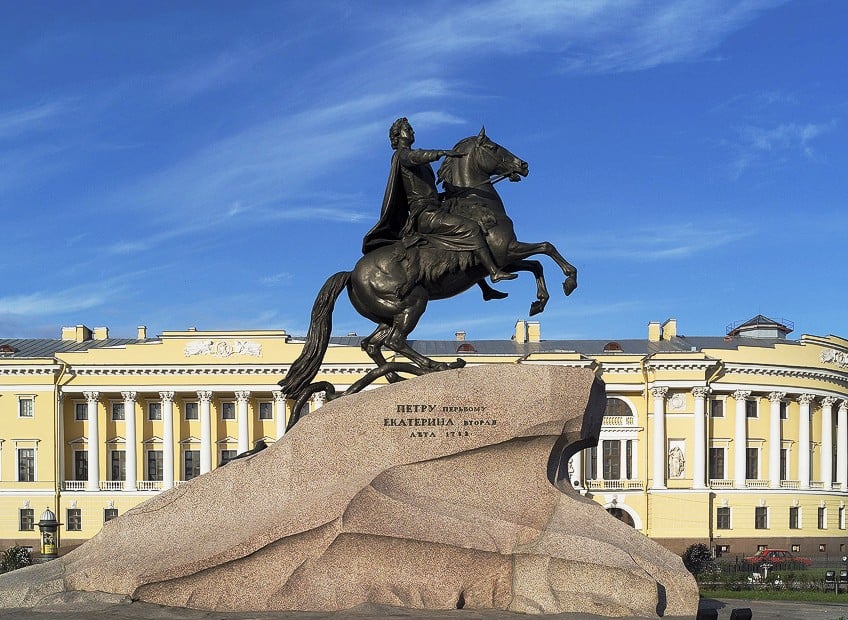
This stone is significant since it is recognized as the heaviest piece of granite moved by humans and weighs approximately 1,250 tons. The sculpture also inspired the famous poem The Bronze Horseman by Alexander Pushkin in 1833, which became one of the greatest pieces of Russian literature.
The Gates of Hell (1880 – 1917) by Auguste Rodin
| Artist Name | Auguste Rodin (1840 – 1917) |
| Date | 1880 – 1917 |
| Medium | Bronze and plaster |
| Dimensions (cm) | 636.9 x 401.3 x 84.8 |
| Where It Is Housed | The Rodin Museum, Philadelphia, United States |
The Gates of Hell is one of the most famous sculptural creations of the late 19th century that was modeled in 1880 and later cast around 1917. The sculpture was designed and sculpted by Auguste Rodin, who received a commission in 1880 for a project for a Parisian museum.
The monumental bronze door sculpture became the source of Rodin’s inspiration for later sculptures such as The Thinker and The Kiss. The door itself was inspired by the work of Dante Alighieri and his seminal poem The Divine Comedy.
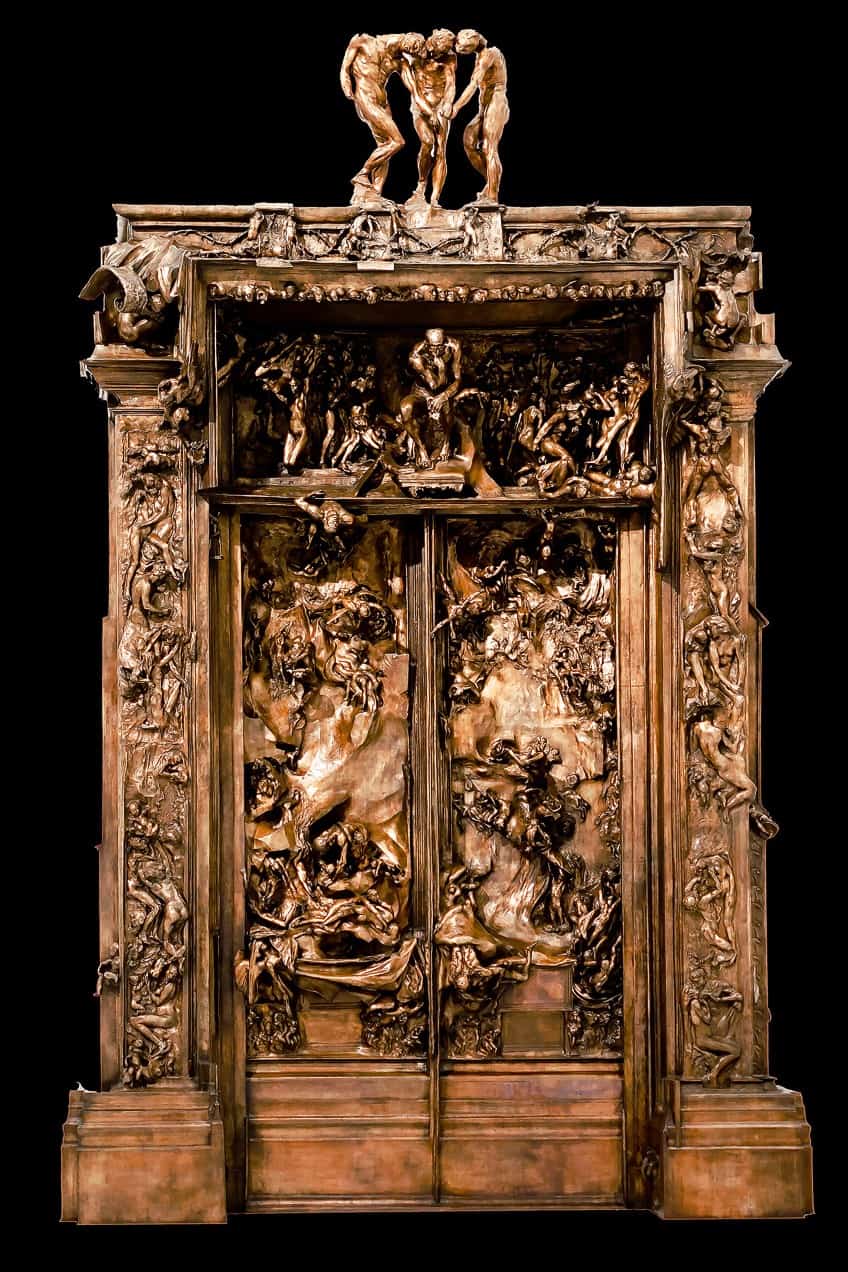
Rodin interpreted the realm of Inferno as a limitless space of chaos featuring around 200 figures depicted in agony, punishment, and love. Over time, the sculpture gained popularity for its depiction of universal human experiences since Rodin’s figures were also portrayed with unapologetic emotive qualities. The sculpture itself was not realized until after Rodin’s death. Before then, it remained a plaster piece in his studio. Today, there are several casts housed in institutions around the world, with the most popular bronze at the Rodin Museum in Philadelphia.
The Bronco Buster (1895) by Frederic Remington
| Artist Name | Frederic Remington (1861 – 1909) |
| Date | 1895 |
| Medium | Bronze |
| Dimensions (cm) | 57.8 x 47.6 x 35.6 |
| Where It Is Housed | Kelly Drive, Fairmount Park, Philadelphia, United States |
A symbol of the White cowboy and the American West, The Broncho Buster is one of the most famous bronze sculptures of the 19th century that was created by Frederic Remington in 1895. The energetic and emotive sculpture captures the spirit of the West in the image of a cowboy rearing a broncho horse.
The sculpture’s image was inspired by one of Remington’s earlier pieces Pitching Broncho and once cast, became the first bronze sculpture to depict a cowboy.
The Bronco Buster (1895) by Frederic Remington; Frederic Remington, CC0, via Wikimedia Commons
Over 300 copies of the work exist today, with a copy of the original produced by the Henry-Bonnard Bronze Company for the Art Institute of Chicago and another original located on Kelly Drive in Fairmount Park, Philadelphia.
The Thinker (1904) by Auguste Rodin
| Artist Name | Auguste Rodin (1840 – 1917) |
| Date | 1904 |
| Medium | Bronze |
| Dimensions (cm) | 200.7 x 130.2 x 140.3 |
| Where It Is Housed | Musée Rodin, Paris, France |
Formally known as Le Penseur, The Thinker is widely recognized as a masterpiece bronze sculpture depicting an introspective man in a pensive position. The famous bronze was created by the renowned French sculptor Auguste Rodin in 1904 and is currently on exhibit at the Musée Rodin in Paris. This iconic bronze statue was modeled after the wrestler Jean Baud and became a symbol of intellectual depth, philosophy, and profound contemplation.
The heroic nude figure remains an important sculpture that was originally conceived during Rodin’s preparation for The Gates of Hell project.

The symbolism and significance of the sculpture encompasses the human capacity for engaging with internal struggles of the mind and is perhaps a nod to the emotive depth of philosophy. Since its creation, many copies have been produced in its place, which expands the emblem of The Thinker and what it stands for.
Sleeping Muse (1909 – 1910) by Constantin Brâncuși
| Artist Name | Constantin Brâncuși (1876 – 1957) |
| Date | 1909 – 1910 |
| Medium | Bronze |
| Dimensions (cm) | 15.2 x 24.1 x 17.1 |
| Where It Is Housed | Metropolitan Museum of Art, New York City, United States, Art Institute of Chicago, Illinois, United States, and Musée National d’Art Moderne, Paris, France |
Sleeping Muse is a renowned bronze sculpture of a resting human head that was created by Constantin Brâncuși between 1909 and 1910. The famous bronze evokes feelings of surrender and serenity, which makes for a beautiful expression of rest, rendered in a minimalistic fashion. Brâncuși approached the sculpture with incredible simplicity, which emphasizes fundamental forms over the unnecessary details that detract us from his vision.
The bronze head is one of four original casts produced in 1910 from a marble copy to convey a sense of languor and express the weight of inertia.
Brâncuși was inspired by the model Renée Irana Franchon, whose form was used to embody repose. Brâncuși was also known to reject conventional modes of sculpture and favored direct carving techniques inspired by Cycladic, Romanian, and African cultures.
The Little Mermaid (1913) by Edvard Eriksen
| Artist Name | Edvard Eriksen (1876 – 1959) |
| Date | 1913 |
| Medium | Bronze |
| Dimensions (cm) | 125 (h) |
| Where It Is Housed | Langelinie promenade, Copenhagen, Denmark |
The Little Mermaid is among the most famous bronze statues in Copenhagen, which was created in 1913 by Edvard Eriksen. The sculpture was commissioned by Carl Jacobsen in 1909 and was inspired by the ballerina Ellen Price and the work of Hans Christian Andersen. Since the sculpture’s unveiling, it has become an iconic and enduring piece that has attracted both admirers and activists.
Throughout the years, the sculpture faced many counts of vandalism, however, it remains a resilient statue in the Langelinie promenade.
The Vine (1921) by Harriet Whitney Frishmuth
| Artist Name | Harriet Whitney Frishmuth (1880 – 1980) |
| Date | 1921 |
| Medium | Bronze |
| Dimensions (cm) | 212.1 x 126 x 72.4 |
| Where It Is Housed | The Metropolitan Museum of Art, New York City, United States |
The Vine is among the best bronze sculptures of the 20th century that was inspired by the elegance of the human form and dance. The famous bronze statue was created by Harriet Whitney Frishmuth in 1921 and depicts the lyrical figure of a nude female dancer with her arms outstretched, which mimics the tendrils of a vine.
Recognized as a moment of “performance ecstasy”, the figure appears to grasp a grapevine, which complements her movement and graceful pose.
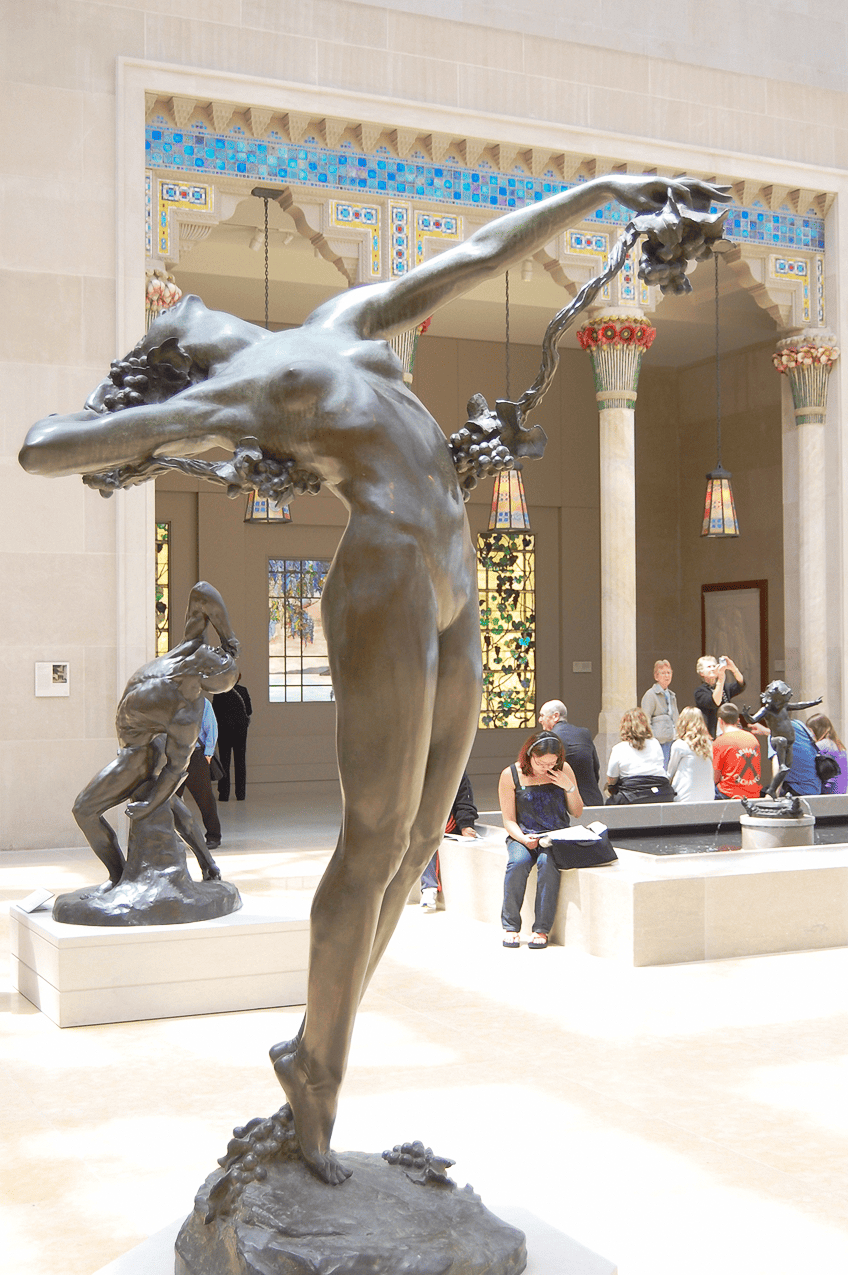
For her work, Frishmuth employed the assistance of ballet dancer Desha Delteil, who inspired the form of the sculpture through the remarkable command of her body. This fascinating statue quickly grabbed the attention of the public and led to the creation of 396 additional copies.
L’Homme au Doigt (1947) by Alberto Giacometti
| Artist Name | Alberto Giacometti (1901 – 1966) |
| Date | 1947 |
| Medium | Bronze |
| Dimensions (cm) | 179 x 103 x 42 |
| Where It Is Housed | Museum of Modern Art, New York City, United States, and Tate Gallery, London, United Kingdom |
L’Homme au Doigt is also recognized as Pointing Man and is a famous bronze statue that hit the record for the most expensive bronze sculpture in 2015 after selling for $ 141.3 million. L’Homme au Doigt was created by the renowned Swiss sculptor Alberto Giacometti in 1947 and was part of six casts plus an additional artist’s proof.
The creation of the iconic sculpture follows a night of creativity by Giacometti, who was motivated by an exhibition deadline.
Thus, the dainty bronze statue was born “between midnight and nine the next morning”. The form of the sculpture is characterized by an elongated figure, which made its impact more profound given that it was shaped by the influences of African art, Cubism, and Surrealism. Today, the statue remains in the collections of museums such as the Des Moines Art Center, the Museum of Modern Art, and the Tate Gallery.
Maman (1999 – 2002) by Louise Bourgeois
| Artist Name | Louise Bourgeois (1911 – 2010) |
| Date | 1999 – 2002 |
| Medium | Bronze, marble, and stainless steel |
| Dimensions (cm) | 927.1 x 891.5 x 1023.6 |
| Where It Is Housed | Long Museum, Shanghai, China |
Maman is one such bronze sculpture that cannot be dismissed as a famous work of art and a testament to monumental bronze sculptures. The large spider-like sculpture was created by Louise Bourgeois and features a sac-like structure containing 32 eggs crafted from marble. The sculpture was initially produced in 1999 and later cast in 2002.
The title of the sculpture Maman, translates to “Mummy” and is part of a series of large steel spider sculptures that Bourgeois created in the late 1990s.
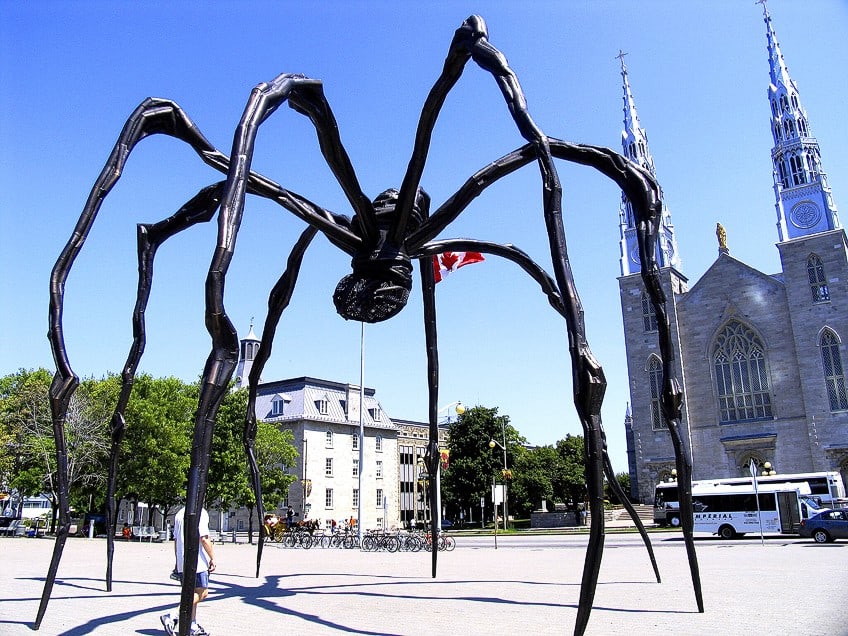
The image of the spider emerged from Bourgeois’ earlier drawings in 1947, which represented her exploration of contradiction, childhood terror, and maternal instinct. Through her sculptures, Bourgeois confronts complex emotions like fear and love by channeling personal experiences into universal symbols that speak to the complicated dynamics many experience with a significant maternal figure.
These famous bronze sculptures and statues showcase the remarkable quality of sculpture in the past, which has influenced many generations of artists to embrace the wonders of bronze sculpture. The medium itself is a testament to both ancient and modern creativity that was used to communicate complex emotions and express the mythologies that once captivated many.
Frequently Asked Questions
What Is the Biggest Bronze Sculpture in the World?
Ushiku Daibutsu (1933) by the Higashi Honganji Temple is recognized as the biggest bronze sculpture in the world. The 120-meter-tall bronze statue depicts Amitabha Buddha and is located in Ushiku in Japan.
What Is the Oldest Bronze Sculpture?
Dancing Girl from Mohenjo-daro (c. 2500 BCE) is recognized as one of the oldest bronze statues in the world that was created by the Harappan civilization. The statue was unearthed by Ernest Mackay in 1926 and is currently housed at the National Museum in New Delhi, India.
What Is the Most Expensive Bronze Statue in the World?
L’homme Au Doigt (1947) is regarded as the most expensive bronze statue in the world, since it sold at auction for $ 141.3 million in 2015. The sculpture was created by Alberto Giacometti and is also referred to as Pointing Man.
Jordan Anthony is a Cape Town-based film photographer, curator, and arts writer. She holds a Bachelor of Art in Fine Arts from the University of the Witwatersrand, Johannesburg, where she explored themes like healing, identity, dreams, and intuitive creation in her Contemporary art practice. Jordan has collaborated with various local art institutions, including the KZNSA Gallery in Durban, the Turbine Art Fair, and the Wits Art Museum. Her photography focuses on abstract color manipulations, portraiture, candid shots, and urban landscapes. She’s intrigued by philosophy, memory, and esotericism, drawing inspiration from Surrealism, Fluxus, and ancient civilizations, as well as childhood influences and found objects. Jordan is working for artfilemagazine since 2022 and writes blog posts about art history and photography.
Learn more about Jordan Anthony and about us.
Cite this Article
Jordan, Anthony, “Famous Bronze Sculptures – Explore 15 Metal Marvels.” artfilemagazine – Your Online Art Source. December 19, 2023. URL: https://artfilemagazine.com/famous-bronze-sculptures/
Anthony, J. (2023, 19 December). Famous Bronze Sculptures – Explore 15 Metal Marvels. artfilemagazine – Your Online Art Source. https://artfilemagazine.com/famous-bronze-sculptures/
Anthony, Jordan. “Famous Bronze Sculptures – Explore 15 Metal Marvels.” artfilemagazine – Your Online Art Source, December 19, 2023. https://artfilemagazine.com/famous-bronze-sculptures/.


